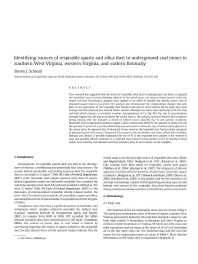Mining Publication: Identifying Sources of Respirable Quartz and Silica Dust in Underground Coal Mines in Southern West Virginia, Western Virginia, and Eastern Kentucky
Original creation date: April 2009
Prior research has suggested that the source of respirable silica dust in underground coal mines is typically the immediate top or bottom lithology adjacent to the mined seam, not mineral matter bound within the mined coal bed. Geochemical analyses were applied in an effort to identify the specific source rock of respirable quartz dust in coal mines. The analyses also demonstrate the compositional changes that take place in the generation of the respirable dust fraction from parent rock material. All six mine sites were mining coal with relatively low mineral matter content, although two mines were operating in the Fire Clay coal bed which contains a persistent tonstein. Interpretations of Ca, Mg, Mn, Na, and K concentrations strongly suggest that the top strata above the mined seam is the primary source of mineral dust produced during mining. One site indicates a mixed or bottom source, possibly due to site specific conditions. Respirable dust compositional analyses suggest a direct relationship between the quantity of mineral Si and the quantity of quartz Si. A similar relationship was not found in either the top or bottom rocks adjacent to the mined seam. An apparent loss of elemental Al was noted in the respirable dust fraction when compared to potential parent rock sources. Elemental Al is present in top and bottom rock strata within illite, kaolinite, feldspar, and chlorite. A possible explanation for loss of Al in the respirable dust samples is the removal of clays and possibly chlorite minerals. It is expected that removal of this portion of the Al bearing mineral matter occurs during rock abrasion and dust transport prior to dust capture on the samplers.
Authors: SJ Schatzel
Peer Reviewed Journal Article - April 2009
NIOSHTIC2 Number: 20035050
Int J Coal Geol 2009 Apr; 78(2):110-118
See Also
- Control of Respirable Dust
- The Effects of Low Quartz Mass Loading and Spatial Variability on the Quartz Analysis of Surface Coal Mine Dust Samples
- Evaluation of the Approach to Respirable Quartz Exposure Control in U.S. Coal Mines
- Improving Silica Dust Control Through Targeted Research
- Improving the Performance of Fan-Powered Dust Collectors in Stone-Cutting Applications
- Laboratory Evaluation of a Canopy Air Curtain for Controlling Occupational Exposures of Roof Bolters
- Reducing Enclosed Cab Drill Operator's Respirable Dust Exposure at Surface Coal Operation With a Retrofitted Filtration and Pressurization System
- Reducing Respirable Dust Concentrations at Mineral Processing Facilities Using Total Mill Ventilation Systems
- Research Toward Direct Analysis of Quartz Dust on Filters Using FTIR Spectroscopy
- Respirable Quartz Hazard Associated with Coal Mine Roof Bolter Dust
- Content source: National Institute for Occupational Safety and Health, Mining Program


 ShareCompartir
ShareCompartir
